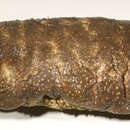Actinopyga: Brief Summary
provided by wikipedia EN
Actinopyga is a genus of sea cucumbers found in coastal waters in tropical and temperate regions.
- license
- cc-by-sa-3.0
- copyright
- Wikipedia authors and editors
Diagnosis
provided by World Register of Marine Species
Life size from moderate to very large (400 mm) in length; body stout with thick and firm body wall, covered by prominent ambulatory tube feet ventrally and, numerous, modified, elongate tube feet (= “papillae”) dorsally; mouth ventral, surrounded by 15–30 large, peltate tentacles; calcareous ring firm, radial pieces about twice as large as interradial pieces; anus dorsal to terminal, guarded by five, nearly always prominent, heavily calcified terminal tube feet (= “anal teeth”). Ossicles in body wall rosettes and straight to branched, smooth or spiny, rods; tentacles with rods of various sizes and forms, often spiny at extremities; tube feet and papillae with rods and rosettes similar to those of body wall, but often with more complex branched rods; longitudinal and cloacal retractor muscles with rods similar to the simple, smooth ones from the body wall; gonad with rods similar to those of body wall; cloacal wall with spiky rods. Tables, buttons or other ossicle types absent from all tissues. Cuvierian organs present or absent, when present never expelled, non-sticky and composed of three distinct parts: (i) smooth proximal half of trunk, (ii) slightly rugged distal half of trunk, and (iii) highly ragged elongated primary and secondary branches.
Samyn, Y.; Vandenspiegel, D.; Massin, C. (2006). A new Indo-West Pacific species of Actinopyga (Holothuroidea: Aspidochirotida: Holothuriidae). Zootaxa. 1138: 53-68.
- license
- cc-by-4.0
- copyright
- WoRMS Editorial Board


